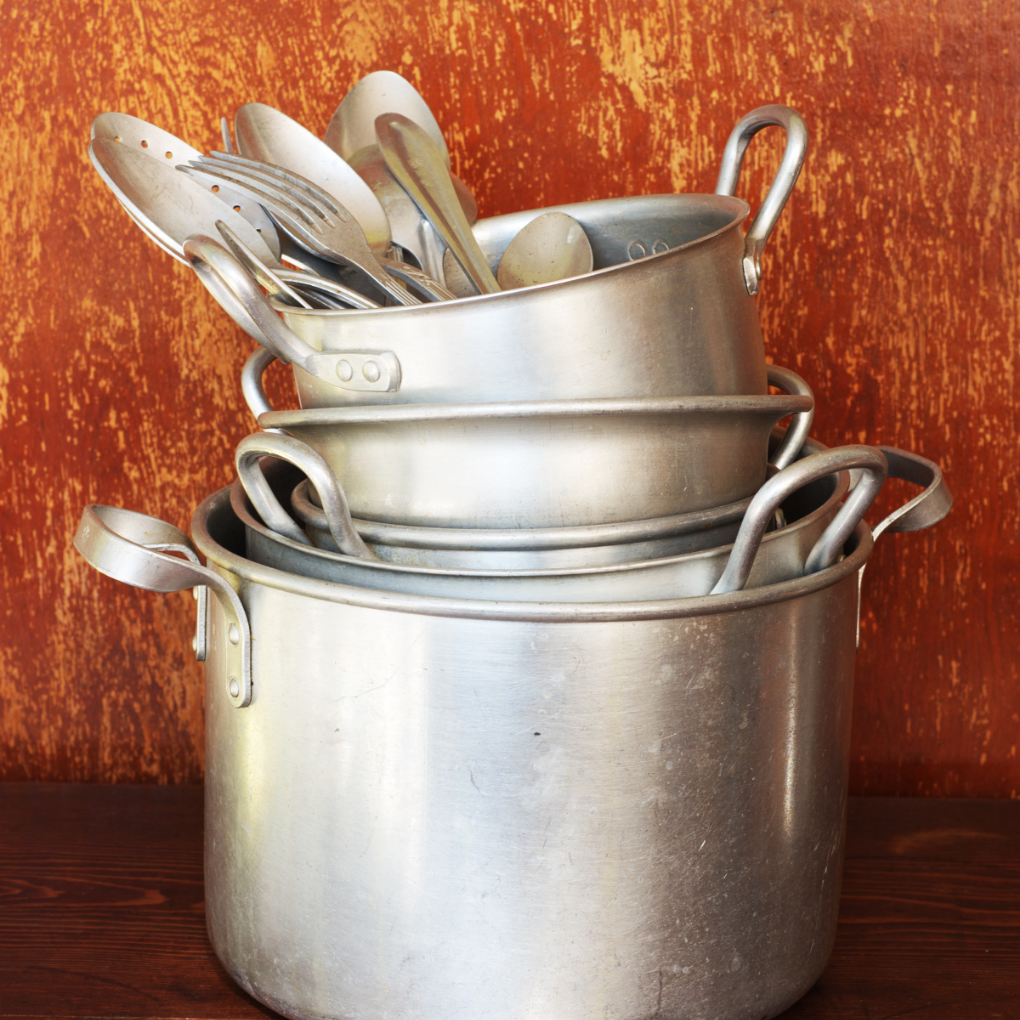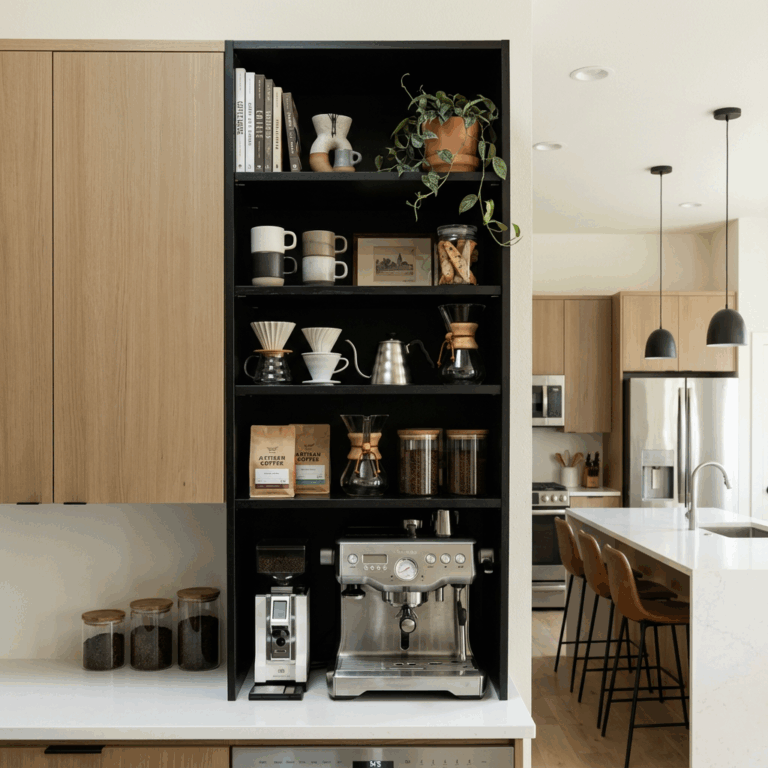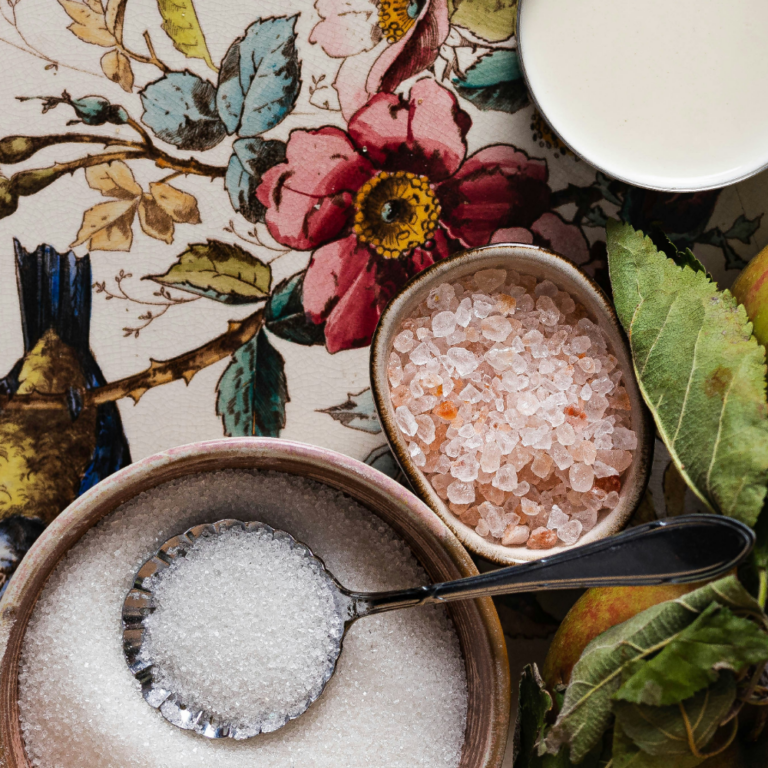
Key Takeaways
- Health experts say aluminum pans are generally safe for healthy adults, with only small amounts of metal leaching into food.
- Leaching is more likely with acidic or salty foods, long cooking times, and scratched or worn pans.
- Hard-anodized aluminum pans provide a safer, non-reactive surface that minimizes exposure.
If you cook at home, chances are you’ve got at least one aluminum pan in your kitchen. But many people still wonder: Are aluminum pans safe for everyday cooking?
Aluminum cookware is one of the most widely used worldwide, with the global market valued at $6.25 billion in 2024 and expected to keep growing. Its popularity comes from being lightweight, affordable, and quick to heat.
At the same time, safety questions linger from small amounts of aluminum leaching into food to concerns about a possible link with Alzheimer’s disease.
In this article, we’re focusing on reusable aluminum cookware — the skillets, pots, and pans you use daily — not disposable trays or foil. The short answer? Aluminum pans can be safe, especially if you choose the right type and use them properly. Below, we’ll break down the pros and cons, explain why anodized aluminum is different, and share simple tips to lower any risks.
Are Aluminum Pans Safe for Your Health?
The primary health concern with aluminum pans is leaching when small amounts of aluminum seep into food during cooking. This is most likely to happen if you:
- Cook acidic foods, like tomato sauce or citrus
- Use scratched, pitted, or worn pans
- Cook at very high heat for long periods
So, are aluminum pans dangerous? Health experts, including the World Health Organization and Health Canada, agree that the small amount of aluminum that might migrate from cookware is not harmful for healthy adults. In fact, most of the aluminum we consume comes from food additives, not from pots and pans.
⚠️Who Should Be Careful?
Most people can safely use aluminum pans, but there are a few exceptions. People with kidney disease should be more cautious, since their bodies have a harder time clearing aluminum from the bloodstream.
You may also have heard about a possible link between aluminum and Alzheimer’s disease. Research has not proven a direct connection. According to organizations such as the Alzheimer’s Society and the World Health Organization, everyday cookware is not considered a significant risk factor.
Aluminum pans are safe for healthy adults, but anyone with kidney problems should consult their doctor about limiting exposure.
Advantages of Aluminum Cookware
So why do so many people reach for aluminum pans? It really comes down to a mix of performance and practicality. Here are the most significant perks:
Heats Up Fast and Evenly
Aluminum is one of the best heat conductors in the kitchen. It warms up quickly and spreads heat across the pan so you don’t end up with hot spots that burn your food. That’s why it’s a favorite for stir-fries, searing, or anything that needs precise temperature control.
Lightweight and Easy to Handle
If you’ve ever struggled to lift a heavy cast-iron skillet, you’ll appreciate the ease of aluminum. Even larger pots are light enough to carry easily, which makes them a good choice for big pasta dinners, camping, or outdoor cooking.
Budget-Friendly
Compared to stainless steel or copper, aluminum is much more affordable. You don’t have to spend a fortune to get a solid set of pans that cook well.
Versatile for Everyday Meals
From frying eggs in the morning to boiling soup or making a quick stir-fry at night, aluminum cookware can handle a wide range of cooking tasks. Heavy-gauge aluminum pans are particularly suitable for large-batch cooking, as they distribute heat uniformly.
Responsive to Temperature Changes
Need to turn down the heat fast so your sauce doesn’t burn? Aluminum reacts almost instantly. This rapid heat response gives you more control in the kitchen compared to slower-heating materials, such as cast iron.
Aluminum pans are light, affordable, and dependable — which explains why they’ve earned such a permanent spot in kitchens around the world.
Do Cookware Pans Release Plastic Particles?
When most people think about plastic in the kitchen, they picture storage containers or utensils — not their frying pan. But the truth is that some types of cookware can release tiny fragments that act like microplastics when they break down.
🍳 Nonstick pans (like Teflon/PTFE)
Scratched or overheated nonstick coatings can degrade into small flakes. These are polymer-based materials, not natural compounds, and studies show they can behave like microplastics (under 5 mm) or even nanoplastics (so small they may pass through human cells). A 2022 study estimated that just one damaged nonstick pan could shed tens of thousands of plastic particles into food.
🍳 Ceramic-coated pans
While marketed as a safer or “eco” alternative, not all ceramic cookware is created equal. Some lower-quality ceramic pans are applied over a polymer or aluminum base, meaning they’re not entirely free from plastics. With repeated use at high heat or rough scrubbing, these coatings can chip, crack, or wear down, releasing plastic-like fragments or fine ceramic dust into food. Higher-quality ceramic pans, made with reinforced coatings and no polymer underlayer, are generally safer but still require gentle care to prevent chipping.
🍳 Aluminum, stainless steel, and cast iron pans
The good news: metals don’t release plastic particles. The primary safety concern here is metal leaching (like aluminum or nickel), not microplastics. Choosing anodized aluminum and avoiding very acidic foods in bare aluminum pans are simple ways to cook safely without introducing plastic contamination.
When Does Aluminum Leach Into Food?
Aluminum pans don’t always leach into food; it depends on how you cook and the condition of the pan. The main factors include:
- Acidic foods: Cooking tomato sauce, vinegar-based dishes, or citrus-heavy recipes in bare aluminum pans speeds up leaching because acid reacts with the metal.
- Salty foods: Consuming long-simmered soups, stews, or pasta water with excessive salt can increase aluminum release, especially in thin pans.
- High heat and long cooking times: Quick sautéing is usually fine, but simmering or braising for hours in bare aluminum encourages more leaching.
- Scratches, pitting, or wear: Damage to the surface removes the natural oxide layer that protects, typically aluminum, exposing raw metal to food.
- Harsh detergents: Steel wool or strong cleaners can strip away the protective oxide layer, making the surface more reactive.
Many home cooks choose anodized aluminum pans instead, since the anodization process creates a hard, non-reactive surface that significantly reduces leaching risks.
How Does Anodized Aluminum Improve Safety?
One of the best ways to make aluminum cookware safer is through a process called anodization. This is when the surface of the pan is treated in an acidic electrolyte bath, and an electric current is passed through it. The process changes the surface of the aluminum into a tough layer of aluminum oxide.
That new surface makes a big difference:
- Non-reactive – Food doesn’t come into direct contact with the raw aluminum.
- Resists corrosion – Acidic foods like tomato sauce won’t break it down as easily.
- Scratch-resistant – Hard anodized aluminum is stronger than stainless steel.
- Keeps the heat benefits – You still get aluminum’s fast and even heating.
Some anodized pans are also finished with a nonstick coating, which can make cooking and cleanup easier. Just remember that once the nonstick layer wears down, the safety depends on the anodized surface underneath, not the coating itself.
For anyone who appreciates the affordability and performance of aluminum but is concerned with leaching, hard-anodized cookware is one of the safest options available.
✨tips
Choosing the Right Aluminum Cookware
If you’re thinking about adding aluminum pans to your kitchen, these simple tips will help you choose wisely and cook more safely:
- Pick anodized when possible: Anodized or hard-anodized aluminum features a protective surface that’s non-reactive, scratch-resistant, and safer for everyday use.
- Choose heavy-gauge pans: Thick aluminum holds heat better, resists warping, and lasts longer than thin, lightweight versions.
- Match the cookware to the food: Use aluminum for quick cooking like sautéing, stir-fries, or boiling water. Save long, acidic recipes (like tomato sauce) for stainless steel or enamel-coated pans.
- Replace worn cookware: Scratches, dents, or pitting are signs that the protective layer has broken down. Swap it out before it starts leaching more aluminum.
- Consider size and function: Large aluminum pots are ideal for boiling pasta or soup, while anodized skillets are perfect for daily stovetop cooking.
How to Use Aluminum Pans Safely
Aluminum cookware can be part of a safe kitchen, but how you use and care for it matters. Here are a few practical tips:
- Avoid acidic foods in bare aluminum: Tomato sauce, vinegar-based dishes, or citrus-heavy recipes can react with aluminum. Save those meals for stainless steel, enamel, or glass cookware.
- Don’t store food in aluminum pans: Cooking in aluminum is fine, but leaving leftovers in the pan can increase leaching. Always transfer food to glass or ceramic containers once it cools.
- Handle cleaning gently: Skip steel wool or harsh detergents, which can scratch the surface and strip away the protective oxide layer. Use soft sponges and mild soap instead.
- Check for signs of wear: Scratches, dents, or pitting mean your pan is ready for replacement. Damaged surfaces are more likely to release aluminum into food.
- Cook at moderate heat: There’s no need to blast the burner on high. Aluminum conducts heat so well that medium heat is usually enough, which also helps reduce wear.
When you follow these practices, you can keep the convenience of aluminum while lowering any potential risks.
How to Clean and Maintain Aluminum Pans
Keeping your aluminum pans clean is one of the best ways to extend their life and prevent unwanted leaching. The key is gentle care. Aluminum is durable, but harsh cleaning can strip away its natural oxide layer or scratch anodized coatings. Here’s how to do it safely and effectively.
✨ Everyday Cleaning
After each use, let your pan cool completely before washing. Rinsing a hot pan in cold water can cause warping. Use warm water, mild dish soap, and a soft sponge or cloth to remove food residue.
Avoid steel wool or abrasive scouring pads, which can damage the surface and make the pan more reactive over time.
🧽 Deep Cleaning for Stains or Discoloration
If your pan looks dull or stained, mix a gentle paste of baking soda and water. Apply it to the affected areas and rub lightly with a non-abrasive sponge. Rinse well and dry thoroughly.
For stubborn spots, simmer a mix of water, vinegar, and a spoonful of cream of tartar for 5–10 minutes, then wash as usual. This helps dissolve built-up residue without harming the surface.
💧 Drying and Storage Tips
Always dry your pans immediately after washing to prevent water spots or oxidation. Store them in a cool, dry place, ideally with soft cloths or pan protectors between stacked pans to prevent scratches.
If your pan has a nonstick or anodized surface, avoid nesting heavy cookware directly on top of it.
❌ What to Avoid
- Dishwashers: The detergents and high heat can discolor or corrode aluminum.
- Harsh chemicals: Bleach, oven cleaners, and degreasers can ruin the surface.
- Prolonged soaking: Leaving pans submerged for hours can dull the finish and cause pitting.
With proper care, a well-made aluminum pan can last for years, staying bright, smooth, and safe for everyday cooking.
FAQs About Aluminum Cookware
Yes—aluminum pans are safe for most healthy adults when used properly. Safety improves when you avoid cooking very acidic or salty foods in bare aluminum, use moderate heat, and switch to hard-anodized aluminum for a non-reactive surface.
⚠️However, the FDA has warned about some cheap imported cookware that was found to leach dangerous levels of lead. That doesn’t mean all aluminum is unsafe — it simply highlights the importance of selecting high-quality, food-grade pans from trusted brands over the lowest-cost options.
People with kidney disease should be more cautious because their bodies clear aluminum less efficiently. If you have reduced kidney function, ask your healthcare provider about limiting exposure and favor anodized, stainless steel, or enamel options.
There is no proven link between aluminum cookware and the development of Alzheimer’s disease. While early studies raised concerns about aluminum exposure, more recent research has found the evidence to be inconclusive. According to a 2023 article in ScienceAlert, experts confirm that “aluminum is not linked to dementia,” and that cookware made from aluminum is safe for everyday use.
Coated aluminum uses a nonstick layer (PTFE or ceramic) applied on top, which can wear or scratch over time and expose bare aluminum. Anodized aluminum is electrochemically hardened into an aluminum-oxide surface that’s naturally non-reactive, more scratch-resistant, and longer-lasting without relying on a coating.
Disposable pans are fine for occasional use, but they’re thin, warp easily, and aren’t durable. Yes, aluminum is 100% recyclable—rinse thoroughly to remove food residue and check your local guidelines before placing them in the recycling bin.
For daily use, choose hard-anodized aluminum. Keep the heat moderate and avoid long, acidic, or very salty cooks in bare aluminum. Also, don’t store leftovers in the pan, and replace scratched or pitted cookware. For high-acid recipes, switch to stainless steel, enamel, or glass.
Final Thoughts on Are Aluminum Pans Safe
So, are aluminum pans safe? The answer is yes — when you choose the right type and use it properly. Bare aluminum can leach small amounts of metal into food, especially with acidic or salty recipes; however, anodized and heavy-gauge pans significantly reduce this risk.
For most people, aluminum cookware offers a smart balance of affordability, performance, and convenience. If you’re mindful about what you cook in it, avoid storing food in the pan, and replace damaged pieces, aluminum can remain a safe and reliable part of your kitchen.
And if you’d rather skip aluminum altogether, you have excellent alternatives, such as stainless steel, cast iron, or ceramic cookware. The key is finding cookware that matches your cooking style and makes you feel comfortable about what’s going into your meals.
📚References
- Fellows, K. M., Samy, S., Rodriguez, Y., & Whittaker, S. G. (2025). Evaluating metal cookware as a source of lead exposure. Journal of Exposure Science & Environmental Epidemiology, 35, 342–350. https://www.nature.com/articles/s41370-024-00686-7
- Fortune Business Insights. (2025, August 11). Aluminum cookware market size, share & industry analysis, by product (pots & pans, pressure cooker, and others), by application (residential and commercial), by distribution channel (offline stores and online stores/e-commerce), and regional forecast, 2025–2032. https://www.fortunebusinessinsights.com/aluminum-cookware-market-112091
- Homes & Gardens. (2025, May 2). Is aluminum cookware safe to use? We asked medical experts, toxicologists, and professional chefs for some reassurance. https://www.homesandgardens.com/living/is-aluminum-safe-to-cook-with
- Luo, Y., Tu, C., Zhang, J., Wu, Y., Li, C., Zhou, Q., & Sun, J. (2022). Raman imaging for the identification of Teflon microplastics and nanoplastics released from non-stick cookware. Science of the Total Environment, 851(Pt 2), 158293. https://doi.org/10.1016/j.scitotenv.2022.158293
- Public Health Agency of Canada. (2024, December 4). The safe use of cookware and bakeware. https://www.canada.ca/en/health-canada/services/household-products/safe-use-cookware.html
- ScienceAlert. (2024, February 21). Is your cookware putting you at risk of Alzheimer’s? An expert explains. https://www.sciencealert.com/is-your-cookware-putting-you-at-risk-of-alzheimers-an-expert-explains
- U.S. Food and Drug Administration. (2025, August). FDA issues warning about imported cookware that may leach lead. https://www.fda.gov/food/alerts-advisories-safety-information/fda-issues-warning-about-imported-cookware-may-leach-lead-august-2025





